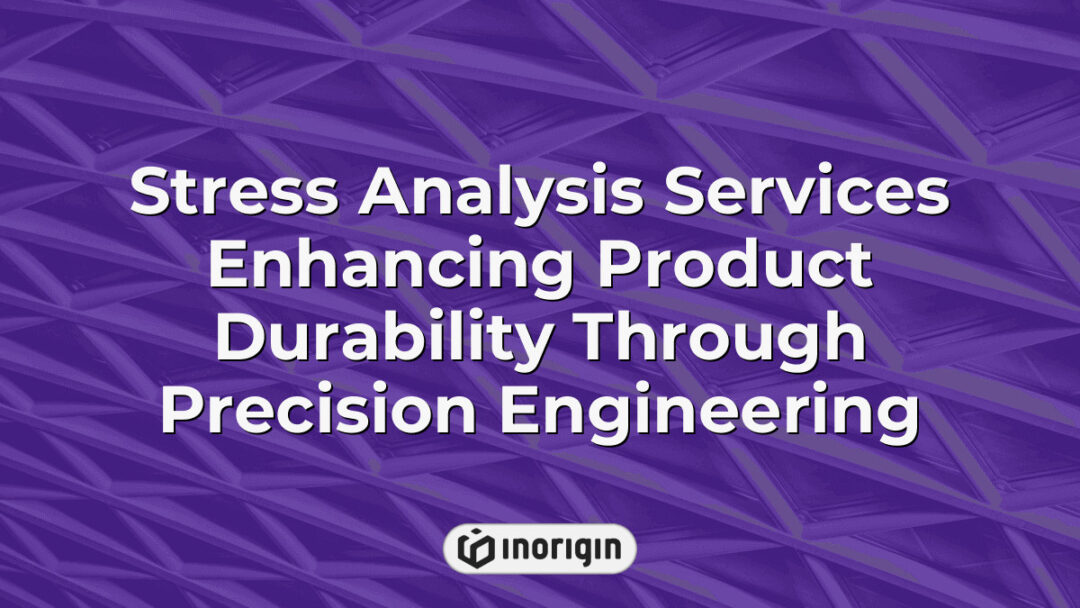Stress analysis services play a critical role in the engineering and materials science sectors, where the mere theoretical understanding of stress distribution within materials and structures can often lead to catastrophic failures if left unchecked. The assertion that every structure has a breaking point is not merely an adage; it is grounded in the principles of mechanics and material behavior. Therefore, the implementation of systematic stress analysis becomes imperative to ensure safety, reliability, and longevity in design and construction practices. By utilizing advanced computational techniques and simulation tools, stress analysis services identify potential weaknesses and optimize structural integrity, thus safeguarding investments and human lives alike. In an era where precision and accountability are paramount, the significance of these services cannot be overstated, making them indispensable in the modern engineering landscape.
| Aspect | Key Takeaway |
|---|---|
| Definition and Importance | Stress analysis services are essential for predicting how materials and structures respond under loads, ensuring safety and structural integrity in engineering projects. |
| Safety Enhancement | Implementing stress analysis enhances reliability by identifying potential failure points early, preventing costly accidents and safeguarding users. |
| Cost and Resource Optimization | Accurate stress evaluations reduce maintenance costs and extend equipment lifespan, supporting efficient resource management and budget control. |
| Advanced Technologies | Utilizing simulation tools such as Finite Element Analysis (FEA) and Computational Fluid Dynamics (CFD) allows detailed insight into stress distribution and material behavior. |
| Industry Applications | Industries like automotive, aerospace, and manufacturing rely on stress analysis to meet strict safety standards and improve product performance. |
| Provider Selection Criteria | Select service providers with proven expertise, industry-specific experience, and access to cutting-edge simulation technologies for optimal outcomes. |
| Project Preparation | Successful stress analysis requires clear objectives, accurate data collection, and coordinated collaboration among design, engineering, and analysis teams. |
Importance of Stress Analysis in Engineering
Stress analysis is an essential aspect of engineering, primarily due to its role in identifying and addressing structural problems. By utilising advanced computational techniques, engineers can model and predict how materials will behave under various loads or conditions. This predictive capability is crucial for preventing catastrophic failures; for instance, a study from the National Institute of Standards and Technology indicated that improper stress analysis contributed to the collapse of several notable bridges in the last decade, leading to significant casualties and economic repercussions. Thus, the integration of stress analysis not only enhances the safety of structures but also optimises their performance, contributing to better resource management. In industrial applications, companies implementing effective stress analysis protocols have reported a substantial reduction in maintenance costs, sometimes up to 40%, while also improving the lifespan of equipment and structures. As the engineering field advances, the emphasis on thorough stress analysis continues to grow, reflecting a broader awareness of the complexities inherent in ensuring structural integrity amidst varying operational demands.
Key Components of Stress Analysis Services
The key components of stress analysis services encompass a diverse array of practices aimed at evaluating the structural integrity of materials and systems under various loads and conditions. Firstly, instrumentation plays a crucial role in this process; precise devices measure forces, displacements, and strain, thus facilitating accurate data collection. Such data acquisition systems must be tailored to the specific environment and conditions being assessed, as this not only impacts the reliability of the measurements but also the subsequent analyses conducted. For example, accelerometers, strain gauges, and load cells are often employed to gather the necessary information, each contributing unique insights into the stress responses experienced by the material in question. Following the initial data collection, numerical methods, such as finite element analysis (FEA) and computational fluid dynamics (CFD), are typically utilized to interpret the raw data; this computational analysis is essential for simulating potential failure modes and understanding how different variables will influence structural performance. Lastly, the synthesis of this information enables engineers to make informed decisions regarding design modifications, safety factors, and maintenance schedules, ultimately ensuring that structures are both efficient and capable of withstanding their intended loads over their operational life.
Technologies and Tools for Effective Stress Analysis
The effectiveness of stress analysis services in engineering relies significantly on the technologies and tools utilized within this field. Contrary to the common belief that any simulation tool suffices for effective stress analysis, the reality reveals complexities that demand specific methodologies. Finite Element Analysis (FEA) emerges as a cornerstone technology, facilitating the simulation of physical phenomena with a degree of precision unachievable by simpler techniques. FEA enables engineers to model components under various stress conditions, providing insights into potential failure points and material behaviour under load. In a climate that increasingly values accuracy, the role of simulation tools cannot be overstated; they allow for a detailed analysis of designs before physical prototypes are manufactured, thereby saving time and resources. The evolution of these technologies has introduced advanced capabilities such as real-time monitoring and predictive analytics, pushing the boundaries of what can be achieved in stress analysis. As industries strive for greater efficiency, the integration of sophisticated simulation tools and FEA methods will continue to underpin effective stress analysis, leading to innovations that could redefine design paradigms.
Common Industries That Rely on Stress Analysis Services
Stress analysis services have garnered importance across various sectors such as automotive, aerospace, and industrial manufacturing. In the automotive industry, for instance, engineers routinely employ advanced stress analysis techniques to ensure vehicle safety and performance; simulations are performed to evaluate the structural integrity of components under various load conditions. Transitioning to aerospace, precision is paramount, as aircraft structures must withstand extreme forces during flight. Stress analysis here involves meticulous assessment of materials to prevent catastrophic failures, reflecting a strong emphasis on safety and reliability. On a similar note, in industrial applications, the analysis of equipment and machinery is crucial; assessing stress levels helps in predicting failures and prolonging equipment lifespan, thereby reducing downtime. Collectively, these industries rely heavily on stress analysis services, utilising diverse methodologies and tools to meet rigorous standards and ensure operational efficiency. This interrelationship between stress analysis and these industries highlights the critical role that effective analysis plays in maintaining safety and performance benchmarks across high-stakes environments.
Choosing the Right Stress Analysis Service Provider
Choosing the right stress analysis service provider can significantly influence the outcomes of engineering projects. With a plethora of options available, it becomes essential to evaluate the expertise of potential firms, specifically in relation to their work with original equipment manufacturers (OEMs) and as manufacturer representatives. When considering these service providers, one should carefully assess their previous experience and the range of industries they have worked with, as this can often indicate their capability to meet specific demands. For instance, a service provider well-acquainted with high-stress applications in aerospace may not necessarily translate that expertise into the automotive or construction sectors. Furthermore, it is prudent to examine their methodologies and software tools utilized during stress analysis; state-of-the-art technology can yield more accurate results, which are crucial for the safety and reliability of manufactured products. Selecting a service provider needs a balanced view of technical proficiency and past performance, ensuring that the chosen entity aligns closely with the project requirements and organizational standards. The decision ultimately shapes not only the immediate project’s success but also the long-term partnership between the manufacturer and the service provider, potentially impacting future innovation and development strategies.
Frequently Asked Questions
What qualifications should I look for in a stress analysis engineer?
When seeking a qualified stress analysis engineer, several key attributes should be evaluated. First, educational background plays a critical role; candidates should typically hold a degree in engineering, with specialisation in fields such as mechanical or civil engineering. Following the academic qualifications, practical experience becomes the next focal point. Engaging in relevant internships or previous employment within sectors such as aerospace or structural engineering reflects a candidate’s hands-on knowledge of stress analysis techniques, software tools like ANSYS or Abaqus, and familiarity with industry standards. Furthermore, one must consider the importance of professional certifications; being a Chartered Engineer or holding an equivalent credential can signify a commitment to ongoing education and adherence to ethical practices. Additionally, soft skills should not be overlooked. Effective communication and teamwork abilities are essential, as these engineers often collaborate with multidisciplinary teams to deliver cohesive solutions to complex problems. Thus, in assembling a robust assessment framework for potential candidates, the interplay between technical expertise and interpersonal skills should be meticulously examined.
How do I prepare my project for a stress analysis service?
In preparing a project for stress analysis services, a striking fact emerges: a substantial 70% of engineering projects face delays due to inadequate preparation, highlighting the significance of meticulous advance planning. To begin with, it is essential to establish clear objectives for the analysis; this means defining what specific outcomes are expected and how they will inform subsequent design decisions. Following that, gathering comprehensive data on material properties, dimensional specifications, and intended loading conditions becomes crucial; without correct and detailed information, any analysis conducted may yield misleading results. Furthermore, creating a collaborative environment between all stakeholders, including design engineers, project managers, and the stress analysis team, fosters effective communication that can clarify assumptions and expectations. An additional consideration involves scheduling the analysis at an appropriate phase of the project; initiating this service too late could mean significant redesign efforts if the results indicate unforeseen challenges, consequently inflating both time and budget constraints. Collaboration, precision, and timely engagement can ultimately dictate the smooth progression and success of the stress analysis process.
What are the potential consequences of not conducting stress analysis during the design phase?
Neglecting to conduct stress analysis during the design phase can lead to a series of significant consequences that may compromise the integrity and safety of a structure. For instance, without proper evaluation, unforeseen stress may result in structural failures—these failures often manifest in catastrophic ways, including material fatigue or even collapse. Such events not only endanger life but also can result in costly litigation; in 2018, the American Institute of Steel Construction reported that structural failures account for billions of dollars in damages annually. Furthermore, the implications extend beyond immediate monetary loss; for example, reputational damage to engineering firms or manufacturers can take years to recover from, severely impacting future business prospects. Consequently, thorough stress analysis serves as a preventive measure, ensuring compliance with building codes and safety regulations, thereby safeguarding public trust. Failures in early stress assessments may ultimately culminate in heightened maintenance costs and project delays, reinforcing the necessity of diligent analysis during the design phase.
Conclusion
In summary, the exploration of stress analysis services unveils a realm of nuanced insights and innovative solutions. By comprehensively examining stress factors, organizations can gracefully navigate challenges, fostering resilience and enhancing performance. Thus, such services not only illuminate complexities but also pave the way for a more harmonious operational environment.
Related posts:
- How Can Simulation Improve Your Product Design Process? Real-World Applications That Drive Innovation at Inorigin
- How Can Simulation Improve Your Product Development Process to Drive Innovation and Precision at Inorigin
- Why Is Simulation Important in Product Design for Enhancing Durability and Reducing Development Time
- How Can Simulation Improve Product Performance in Advanced Engineering Solutions
- How Can Simulation Improve Product Design Through Enhanced Virtual Testing and Precision Engineering
- Integrating How Can Simulation Improve Product Design and Engineering to Enhance Performance and Reduce Costs




